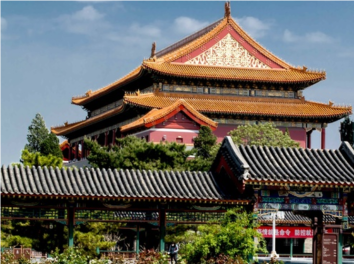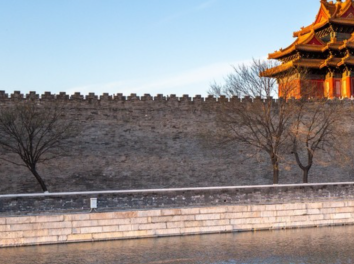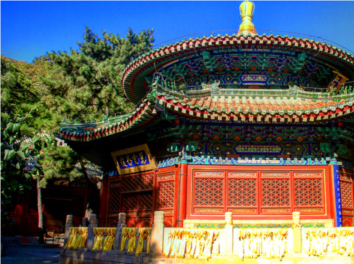Temple of Heaven
The Temple of Heaven is a gem of ancient Chinese architectural art, carrying rich historical and cultural connotations and occupying a central position in the imperial sacrificial activities of the Ming and Qing dynasties.
- Historical and Cultural Significance and Architectural Layout
The Temple of Heaven was the exclusive altar for emperors of the Ming and Qing dynasties to worship heaven, pray for rain, and implore for a bountiful harvest. Its architectural design and layout strictly followed the etiquette norms and philosophical ideas of ancient imperial sacrifices. It is divided into two parts: the Inner Altar and the Outer Altar. This zoning design not only reflects the differences in function but also has profound cultural implications. The Inner Altar is the core area of the entire Temple of Heaven, mainly consisting of important buildings such as the Hall of Prayer for Good Harvests and the Hall of Imperial Vault of Heaven. The Hall of Prayer for Good Harvests is the iconic building of the Temple of Heaven, renowned worldwide for its unique circular architectural structure and exquisite decoration. It adopts the form of a triple-eaved pyramidal roof, and the sapphire-blue glazed tiles shine brightly in the sunlight, symbolizing the sublimity and sacredness of heaven. The structure and decoration inside the hall are full of symbolic meanings. For example, the number and arrangement of the large columns respectively represent the four seasons, twelve months, and twelve two-hour periods of the day. The Hall of Imperial Vault of Heaven is the place where the tablets of the Heavenly Emperor and the ancestors of the emperors are enshrined. The building is solemn and solemn, reflecting the reverence for the ancestors and heaven. The Outer Altar mainly includes some auxiliary buildings and large areas of garden landscapes, echoing with the Inner Altar and jointly forming a large-scale and magnificent sacrificial building complex.

- Intricate Acoustic Phenomena and Embodiment of Ancient Wisdom
Apart from admiring the exquisite architecture of each hall, the ingenious designs such as the Echo Wall and the Triple Sound Stone also make people marvel at the wisdom of the ancients. The Echo Wall is a circular enclosure that cleverly utilizes the principle of sound wave reflection. When a person stands at a specific position inside the enclosure and speaks softly, the sound will travel along the wall and can be clearly heard by people in the distance. This 神奇的声学现象 makes tourists gasp in amazement. The Triple Sound Stone is located on the paved path in front of the Hall of Imperial Vault of Heaven. Standing on this stone and clapping hands, one can hear three or even more clear echoes. This is because the sound waves form a special acoustic effect after being reflected by the surrounding buildings and the ground. These wonderful designs not only demonstrate the superb architectural skills of ancient craftsmen but also reflect the profound understanding and ingenious application of acoustic principles by the ancients, embodying the perfect combination of ancient Chinese science and technology and culture. - Touring Routes and Suggestions
When visiting the Temple of Heaven, people usually enter through the South Gate and exit through the North Gate (or the East Gate), leaving after visiting the Circular Mound Altar, the Hall of Imperial Vault of Heaven, the Danbi Bridge, the Hall of Prayer for Good Harvests, and the Hall of Imperial Vault of Heaven in sequence. After entering through the South Gate, the first thing that comes into view is the Circular Mound Altar, which was the place where the emperor held the grand ceremony of worshiping heaven on the winter solstice. The Circular Mound Altar is an open-air three-story circular stone altar. The number of railings and steps on each floor is related to the number "nine". Because "nine" was regarded as the extreme of yang numbers in ancient times, symbolizing heaven. The Hall of Imperial Vault of Heaven is the place where the tablets of the Heavenly Emperor are enshrined. Its architectural structure is exquisite and complements the acoustic phenomenon of the Echo Wall. Walking across the Danbi Bridge, this passage connecting the two groups of buildings in the north and south is like a "sacred path", making people feel the solemnity of the imperial sacrificial ceremony. Then comes the magnificent Hall of Prayer for Good Harvests. Tourists can carefully appreciate the beauty of the architecture and understand the cultural significance behind it here. Finally, visit the Hall of Imperial Vault of Heaven to complete a full touring experience of the Temple of Heaven. During the visit, it is recommended that tourists rent audio guides or follow tour guides so as to better understand the historical and cultural values contained in each building and scenic spot.


- The Beauty of the Temple of Heaven in Different Seasons - Taking the Early Purple Orchid in April as an Example
Around April each year, the early purple orchid spreads all over the Temple of Heaven, allowing people to experience a strong rural atmosphere without leaving the city. The early purple orchid is a common wild flower, but it forms a dreamy purple flower sea in the Temple of Heaven. They grow freely among the ancient buildings, under the pine and cypress trees, and on the grassland, forming a distinct yet harmonious contrast with the solemn architecture of the Temple of Heaven. When the breeze blows, the flowers sway gently, as if a purple wave is rolling. Tourists strolling among them, with soft grass and delicate flowers under their feet and ancient and mysterious buildings around them, feel as if they are in a poetic painting. The scene of the integration of natural beauty and humanistic beauty makes the Temple of Heaven radiate unique charm in this season, attracting numerous tourists to come and admire and feel the breath of spring. Besides the early purple orchid, the Temple of Heaven also has its own beautiful scenery in other seasons. For example, in summer, there are shady trees; in autumn, the ginkgo leaves turn golden; in winter, the ancient buildings are covered with white snow, each having its own unique flavor.
In addition, there are many activities related to traditional culture and special snacks around the Temple of Heaven. On specific festivals or periods, there will be traditional sacrificial ceremony performances, allowing tourists to more intuitively understand the scenes of ancient imperial sacrifices. In terms of snacks, there are old Beijing specialties such as pea flour cake and donkey roll. Tourists can taste these delicacies while visiting to further experience the traditional culture of Beijing. Meanwhile, there are also some souvenir shops near the Temple of Heaven. Tourists can buy souvenirs with the characteristics of the Temple of Heaven, such as folding fans and bookmarks printed with the pattern of the Temple of Heaven, as a beautiful memory. These surrounding activities and characteristic elements add more fun and cultural atmosphere to the visit of the Temple of Heaven.
TAG:
previous: Badaling Great Wall
next: Summer Palace




